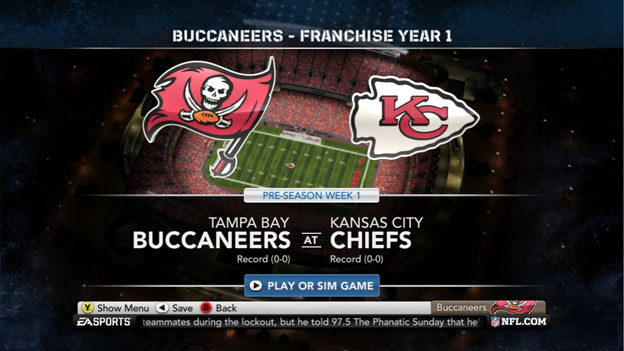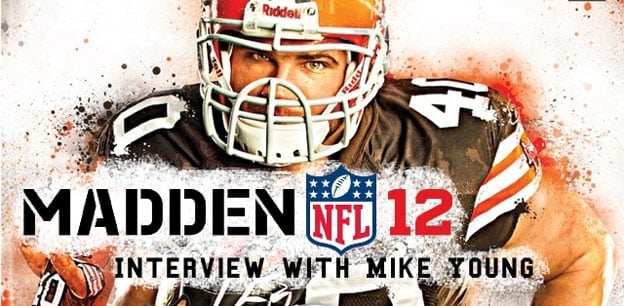Interview with Mike Young, Art Director Madden NFL 12
With the release of Madden NFL 12 a little more than 30 days away, fans of the fabled football franchise are eager to get their hands on the newest installment. To find out what’s new this year and what will be carried over from last year’s effort, we contacted Mike Young, Art Director for Madden NFL 12.
Patriel Manning (Cheat Code Central): How long have you been working with the Madden franchise?
Mike Young (EA, Madden NFL 12): This’ll be my fourth [Madden game].
CCC: What have been the biggest challenges in nailing the look for Madden NFL 12?
MY: Well, the biggest challenge this year was doing more than we ever have in one cycle. I think that we came off of last year and we wanted to make a big splash… We’d been building all these tools for the last couple of years to get there, but we wanted it to look like the game does on TV on Sundays. So a lot of research went into it, a lot of work. To pull off an authentic broadcast you need stadium exteriors and cheerleaders and mascots and runouts, and to do all these things authentically for all 33 teams is a really big undertaking. Having the real camera and all 16 real broadcast cameras in every stadium… it’s a lot of research and it’s a lot of content to create in one year. I felt like we set this really big objective and it was really hard to nail it because you couldn’t just [say] “Oh yeah, these 16 teams are good this year…” So it was really tough to do all those teams all feeling very authentic. Just the fact that we had to build tons of inflatables, different pyro effects… There’s just so much content, so that was the real challenge.

CCC: I was noticing that some of the things you were talking about now were also present in NCAA 12. Did some of that sort of bleed over while you guys were working on Madden?
MY: Well, I think we both look at each other’s game and look at what was kind of successful in the other products—not just our two products, but the other sports games as well—so that’s kind of how we choose to spend our time and effort… What do the fans really want and what’s worth it to go after in one year? So I think we influenced each other in that way. There was some sharing, you know; we both added 3D grass this year, we both added particle kick-ups from the field—guys ripping up the grass, black pellets when you’re on turf—so we do get to build some of the systems together, so that does help. As far as assets, though, they’re totally different.
CCC: What led to the decision to use linear lighting this year instead of something else like image-based lighting?
MY: We not only added linear lighting, but we also added time of day so the shadows are always progressing over the field. The sun is moving through the sky. The first quarter looks different than the fourth quarter. We factored in time zones and Daylight Savings Time, so that was a big deal.
But the linear lighting… really, what it allowed us to do was push our contrast to match TV, but keep our details, the rich details, and keep the accurate colors of the uniforms. If you do a side-by-side between this year’s game and last year’s game you’d see teams like Vikings where the purples just… they shifted and they really didn’t truly represent the Vikings colors. So even though we had the color swatch accurate, the lighting system we had let us down and basically destroyed the image quality. When you see a side-by-side it’s totally apparent.
A lot of people feel like our models are more detailed this year, and they’re really not. What’s happening is that the linear lighting is preserving all of those rich details—the high white ranges and the dark darks—and it makes it feel like you can see all of the high-res texture detail that was kind of blown out or hidden in shadow last year. That was really why. We wanted to look like broadcast; we wanted really rich details. It was very expensive, and that’s why we didn’t get to it earlier. Not expensive [in terms of] performance, just the fact that you have to touch every single asset in the game so that the colors look right. It’s a lot of tuning to do in one year.
CCC: What features are you most excited about?
MY: From the art standpoint, it’s matching TV broadcast shot for shot. This year we did over 700 new cameras that were shot with a virtual camera. We had NFL Films’ cameramen working with us to shoot every scriptable we had in the game… If it’s the Steelers running out, they’ve shot it hundreds of times in their career. They have equipment that matches what they shoot with on game day… shooting it the way they would be. They know where to stand. They know what lens to use. That level of authenticity and that one-to-one translation, that human, you know, that human movement of the camera, it just feels real. That’s the thing I was most proud of and I feel like it’s the highest quality.
CCC: Is it something like what was done in, say, Surfs Up or Avatar?
MY: Exactly. The tech that we developed was inspired by the rigs James Cameron had. What we developed had an HD monitor and it was wireless. For football, our field is 100 yards by 50-ish yards, and so we had a space that basically allowed us a 50-yard-by-25-yard volume, so that allowed us to capture these great scenes where a cameraman has to run out on the field to get the coach handshake and he’s running through a mass of players. That distance hasn’t really been pulled off in a video game before. Usually these systems are very expensive and people are kind of limited to 10-foot-by-10-foot rooms, and they’re wired so they’re kind of limited with the types of camera moves they can have. But we had guys sprinting out of the tunnel following the star player out, and he’s running, you know, thirty yards. That was pretty exciting.
CCC: Have you been able to pinpoint any complaints, either from the fans or the press, that you’ve been able to say “OK, we fixed that”?
MY: Well, the big one was, for us, that franchise mode hadn’t been touched in two or three years in any significant way. That was the harshest criticism against Madden 11 and it was honestly one of our biggest focuses this year, bringing a lot of the best features from a really deep franchise sim we had called Head Coach ’09. We had the lead designer from that game on Madden, and he was bringing really all the hardcore community requests. Things like cut days, expanded rosters, the free agent bidding system, having the teams’ draft logic… there’s basically over a hundred improvements to franchise, several big ones that had been requested for years.

We added the dynamic player performance, which makes players play more like themselves, react appropriately in certain situations; guys like Troy Polamalu we never really represented well before. We had their ratings, which basically captured what you’d capture at an NFL combine, but they didn’t behave the right way. So guys like Mike Vick, even though they were at a high speed rating in the game, they would never take off and take advantage of that skill set. So now we have all these new traits added into Franchise mode and Play now that make the league feel more authentic and real. So Franchise was the big focus, and so far the community has reacted really well to what we’ve announced, and we’re eager to see what they think when they start playing it.
- Page 1
- Page 2
